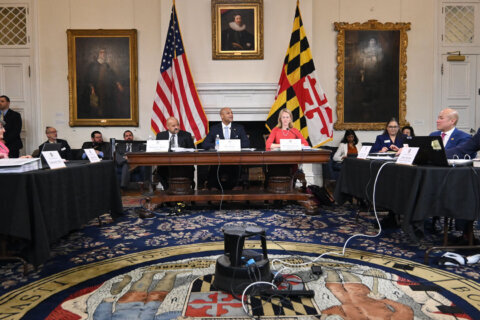FREDERICK, Md. (AP) — Neither Valerie Jean nor Elayne Bond Hyman spent their entire lives in Frederick County, but both have deep roots in the area roots that extend down into the soil itself. For Jean, they trace back to her parents’ home on Madison Street in Frederick, behind the tired tombstones of Mount Olivet Cemetery. Her parents, now dead, built the home themselves after they were denied housing in the still-segregated city.
Until the fourth grade, Jean attended St. John Regional Catholic School to avoid the indignities of a segregated public school system. She can still remember a childhood when black residents of Frederick were afraid to be caught near Baker Park — a municipal amenity then reserved for whites only.
Hyman spent most of her childhood in Washington, D.C., but returned to Frederick seven years ago to trace ancestors who settled in the western part of the county. To Hyman, a poet and author, it’s a sort of cruel irony that neither of her great-great grandparents could read or write. They traveled from Washington County to Frederick County with five children in the mid-1800s, she said, before the start of the Civil War. They set up a homestead in Knoxville along the C&O Canal, and were among the few free black landowners to live and work in Frederick County.
Shortly after they settled here, Hyman said, they were forced to recross South Mountain, back to a courthouse in Hagerstown, to request certificates of freedom.
“It’s another thing that stays with me,” she said. “They had to go to court to be validated and carry these documents everywhere, even though they couldn’t read them. And trust that whoever looked at them would believe them.”
For Jean and Hyman, both writers, it’s a knowledge of family history and their own experiences as women of color that continue to influence their work. Hyman is currently working on a series of monologues tentatively titled “Listen,” which detail the stories of her ancestors from their own perspectives. Jean has written three collections of poetry — including several pieces that helped her win the “Best Poet” award at the 1991 Baltimore Artscape festival — and is in the process of writing a book about her mother, who died in February of last year.
There’s a kinship between the two women, Hyman said, despite their differences. Jean is shy and quiet, Hyman is bolder and voluble, but they’ve known each other for more than a decade, since they first connected in Washington, D.C. as part of the same African-American writers’ group.
Eventually, both stopped attending the meetings. Jean spent more than 30 years working at the University of Maryland library, while Hyman moved to Greenbelt and spent 25 years as an ordained Presbyterian minister. But the two reconnected years later, after a mutual friend learned they had both moved to Frederick.
“I had moved back to take care of my dad,” Jean said, “and I was feeling very isolated.”
“It can be isolating, to be living and writing alone,” Hyman agreed. “I was so excited to find her again.”
At Hyman’s dining room table, inside her airy apartment off West Patrick Street, the two women decided to form another black writers’ group in Frederick — a city where both still sensed a lack of black voices.
It’s true, Hyman said, that Frederick emphasizes history. “But it’s white history,” she said. “It’s European history. It’s not my history.”
She wanted to share stories like her great-great grandparents’, who spent their lives farming in Knoxville. One year, she contacted the City of Frederick and asked to participate in the annual Candlelight House Tour, which showcases historic homes near downtown.
“I have a lot of family relics,” Hyman explained, “and I wanted people to see them.” The city declined, she said, but she took the tour anyway. (A call to Celebrate Frederick, which organizes the event, was not returned, but the tour generally focuses on single-family homes within the vicinity of the downtown historic district.)
Hyman was particularly struck by one house with an extended series of murals painted on the first floor. The home inspired her to commission her own series of paintings on the ceiling of her dining room, depicting stories from family history. Levi Hall and Caroline Virginia, her great-great grandparents’ from Knoxville, are painted on the right-hand side, barefoot as they cross South Mountain. Hyman and Jean meet beneath the mural on a weekly basis to reflect and write, gathering inspiration for their own narratives. Some of Jean’s poems also center on her family — especially her mother — but they’re also an intimate portrait of a black woman navigating the world, shaped by formative experiences like segregation.
“I think anything I write comes from that perspective,” she said. “I can’t escape the fact that I’m writing as a black woman.”
This year, Hyman and Jean were invited to stage a reading of their work by the African-American Heritage Society of Frederick County (AARCH), which was looking for unique ways to recognize Black History Month, said board member Rose Chaney. The event — The Emerging Voices of African-American Writers of Frederick — will feature their work along with historical writing by Damita Drayton Green, a genealogist who has been researching her own family history since 1991.
While Hyman emphasized that she and Jean are proud of their small writers’ group — the two women continue to meet regularly at Hyman’s apartment — she hopes that the reading might draw attention and allow the group to expand.
“It would be nice to have eight to 10 writers,” she said. “I think of us as an incubator, and I would like to hear more voices of color in Frederick.”
“Just the fact that you’re writing about us,” Jean added, “shows this isn’t a common thing.”
Hyman, too, wants to bring black writers together — to avert the feelings of isolation both she and Jean have experienced in the past. One of her strongest memories of the feeling comes from the year she spent as a sophomore at the all-girls Stephens College in Columbia, Missouri. The rural school recruited Hyman from Howard University in the early 1960s, she said, to become the very first student to desegregate the campus.
The school was so predominantly white that Hyman could remember one evening when she was startled to catch a glimpse of her own dark complexion in the hallway on her way to dinner. Another memory emerged from Valentine’s Day the same year, when a huge sheet cake was delivered to the front desk of her dorm. The cake was addressed to her, Hyman said, but the front desk attendant was reluctant to reveal the recipient. When Hyman pressed her, she finally revealed that the cake was delivered by the dormitory cleaner, who had pooled money together with the rest of the school’s predominantly black housekeeping staff.
“I flew up the stairs to thank her,” Hyman said, her eyes welling with tears, “and to ask why they didn’t want me to know. And she said, ‘We’re so proud of you, but we don’t want you to be embarrassed by us.’ The cake was from the groundskeepers, the maids, the cooks, who collectively took care of us. But they worried I would be ashamed of them.”
It was an experience, and a feeling, that continues to resonate with her as she writes.
“It’s why literature, discourse, journaling — all of that — is so important to me,” Hyman added. “It helps me make sense of a world that does not accept or ratify people of color.”
___
Information from: The Frederick (Md.) News-Post, http://www.fredericknewspost.com
Copyright © 2024 The Associated Press. All rights reserved. This material may not be published, broadcast, written or redistributed.







